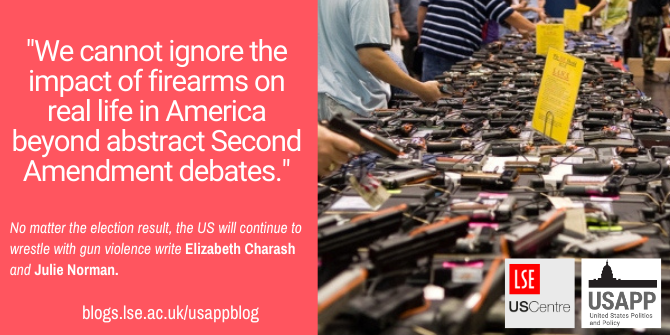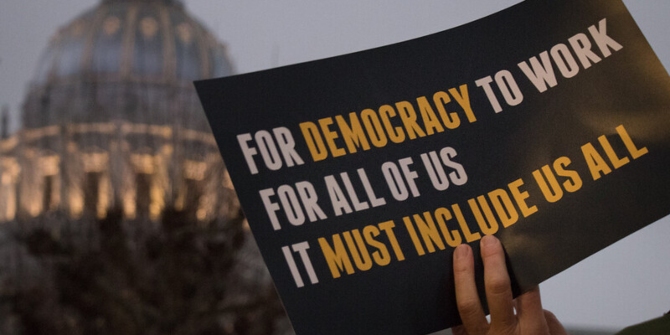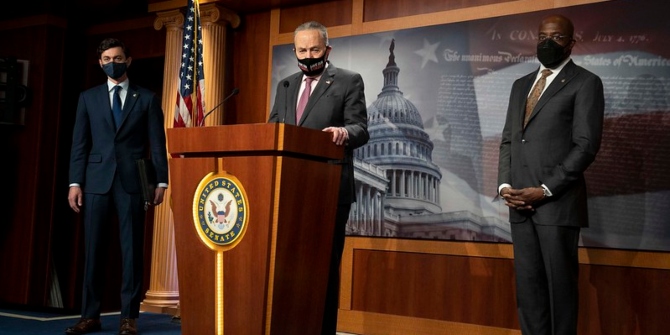
 Tens of thousands of Americans are killed by firearms every year, and yet the issue of gun related violence has been little mentioned in the 2020 presidential election campaign. Elizabeth Charash and Julie Norman write that the ubiquity of guns in America is linked to a greater likelihood of police shootings of civilians, and higher homicide rates for law enforcement officers. The issue of gun violence is not likely to go away, they comment, meaning that policymakers need to think more closely about how firearm ownership is central to the problem.
Tens of thousands of Americans are killed by firearms every year, and yet the issue of gun related violence has been little mentioned in the 2020 presidential election campaign. Elizabeth Charash and Julie Norman write that the ubiquity of guns in America is linked to a greater likelihood of police shootings of civilians, and higher homicide rates for law enforcement officers. The issue of gun violence is not likely to go away, they comment, meaning that policymakers need to think more closely about how firearm ownership is central to the problem.
There is one issue that has been largely absent from the presidential election campaigns this year, even as it undergirds other key concerns such as violent crime, police shootings, and ongoing escalating protests. That issue is how common guns are in in America.
It is no secret that the US has the highest civilian gun ownership rate in the world, with the nearly 400 million firearms in America exceeding the number of people. Put differently, according to the Small Arms Survey, there are over 120 guns for every 100 residents in the US. The second ranked country, Yemen, a state in civil war, has 52.8 guns per 100 residents.
More guns don’t necessarily lead to more crime; rates of both violent and nonviolent crime are comparable to other industrialised countries such as the UK, Australia, Canada, and France. However, more guns are linked with more lethal crime, with assaults in the US three times more likely to involve guns than in other countries. According to a study published in the American Journal of Public Health (AJPH), firearm homicide rates increase 0.9 percent for every percentage point increase in gun ownership.
Gun violence devastates communities, and this includes law enforcement families as well. Indeed, more guns not only links with higher homicide rates of civilians, but also higher rates of homicides of law enforcement officers. As another AJPH study indicated, the homicide rates of law enforcement officers are three times higher in states with high firearm ownership compared with states with low firearm ownership.
Perceptions about the potential threat of gun violence facing US police officers is one reason why there are more killings by police in the US than in other countries. One study found that state-level firearm legislation had a 51 percent lower incidence rate of fatal police shootings than states with the least gun control legislation. Similarly, a Northeastern-Harvard study indicated police shootings were 40 percent more likely to occur in states with more guns.
Though the prevalence of guns does not excuse shootings by police, it does help us understand them better, as American law enforcement officers often assume that a firearm may be involved in almost every encounter. As Derek Thompson summarises in the The Atlantic, “Gun prevalence increases civilian and officer shootings, which makes cops more concerned about getting killed, which in turn leads officers to… escalate conflicts that don’t deserve escalation, and too often, shoot and kill.” Of course, training plays a role as well; it is true that police officers in other countries are more likely to have more training in de-escalation practices than most American police officers. But law enforcement officers in countries like the UK or Canada rarely assume that the person they are engaging with is likely to be armed.
Guns are not the only explanation for high rates of homicides and police shootings in America. There is rightly increasing focus on the racial disparities in police shootings, as well as links between police violence and structural racism. But the prevalence of guns is intertwined with these discussions, too. A recent study indicated that gun homicides are linked to entrenched inequalities such as poverty and lack of social mobility, which correlate with race. Further, as Jennifer Carlson argues in a new book, the current politics of guns and policing must be understood alongside the racial history of America’s institutions, and how they inform racialized disparities between who is perceived as a “good guy with a gun” versus a “bad guy with a gun.”

“Gun Show” by M&R Glasgow is licensed under CC BY 2.0
It is these difficult conversations that the US must continue to wrestle with today. While gun violence prevention has become a winning political issue for many Democrats, especially in down-ballot races, the subject of gun prevalence has not been addressed. To examine this would require a widespread reckoning with our socialized adoption of guns as symbols of protection and personal freedom. It would require that we question growing distrust within our institutions of public safety and government, and demand that our predilections to “keep and bear arms” be contextualised not only in terms of the Bill of Rights, but also the lobbying efforts of the National Rifle Association and the firearms industry.
Gun ownership in the United States is not going away, nor are we arguing that it should. But we cannot ignore the impact of firearms on real life in America beyond abstract Second Amendment debates. Regardless of who wins the election in November, the issues of gun violence, homicides, and police shootings will continue. Rather than viewing firearm ownership as peripheral to these challenges, policymakers, police services, and communities should recognise shared interests in thinking seriously about the prevalence of guns in order to mitigate violence for all citizens and, in doing so, address some of the pivotal issues affecting America today.
Please read our comments policy before commenting.
Note: This article gives the views of the author, and not the position of USAPP– American Politics and Policy, nor of the London School of Economics.
Shortened URL for this post: https://bit.ly/3mKHrPl
About the authors
 Elizabeth Charash – Brady: United Against Gun Violence
Elizabeth Charash – Brady: United Against Gun Violence
Elizabeth Charash is a Partnerships Project Manager with Brady: United Against Gun Violence, and a researcher on violence intervention in the US, Northern Ireland and South Africa.
 Julie Norman – UCL
Julie Norman – UCL
Julie Norman (@DrJulieNorman2) is a Lecturer at the UCL Centre on US Politics (@CUSP_ucl).






